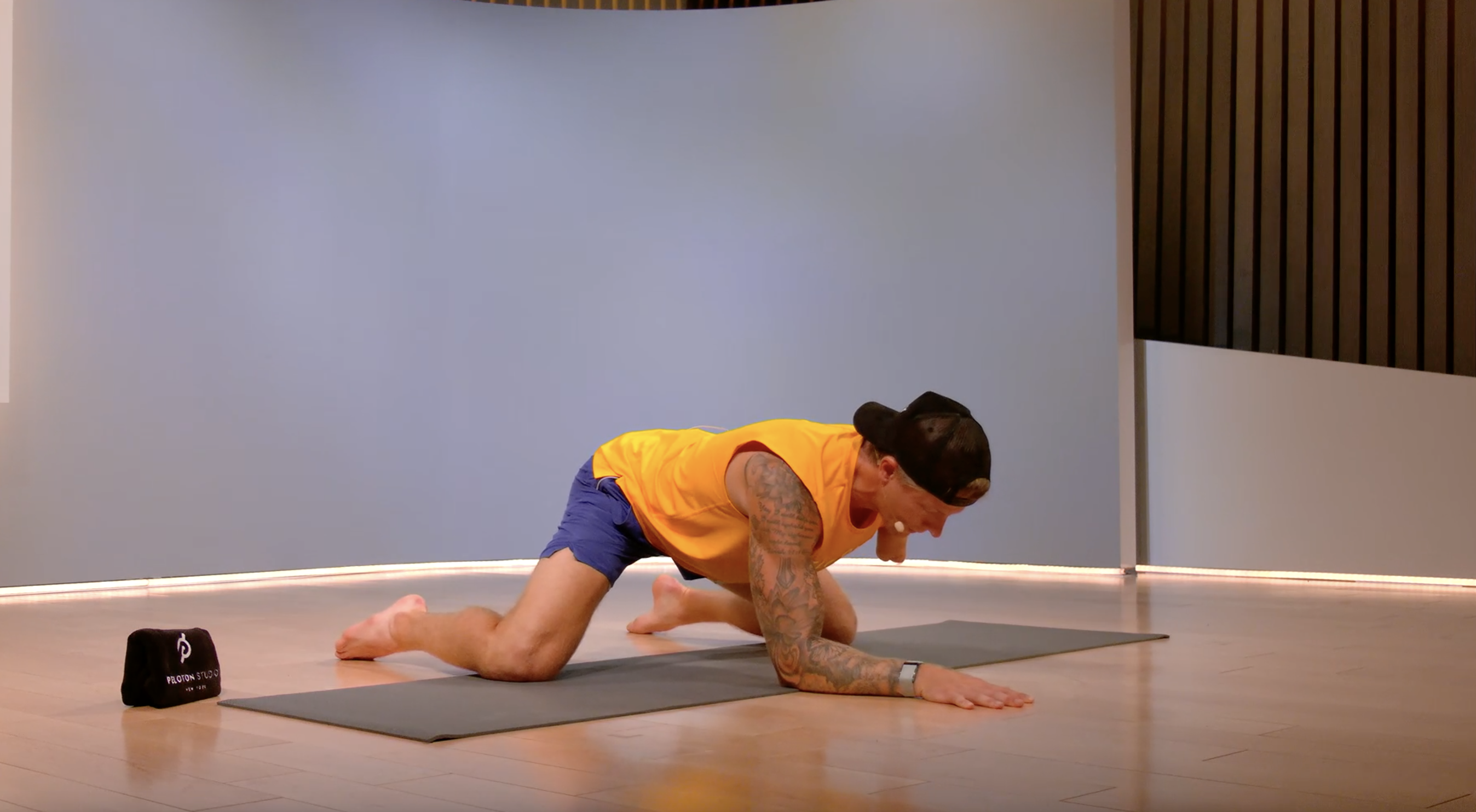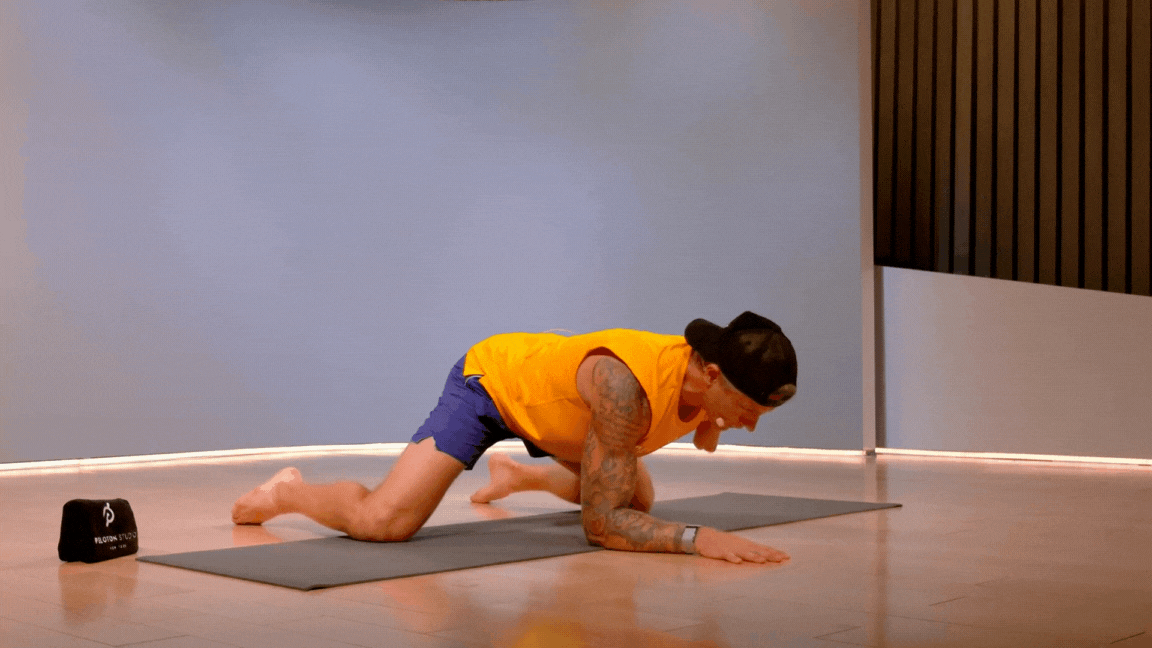
How to Do Frog Stretch for Open Hips and a Strong Lower Back
Your inner thighs will get a good stretch too.
By Leigh Weingus•
Benefits of the Frog Stretch
What to Know Before Doing the Frog Pose
How to Do Frog Pose
After the Stretch
Frog Pose Modifications
Common Frog Stretch Mistakes to Avoid
Of all the stretches out there, “frog stretch” might just have the funniest name…after Camel Pose, that is. In addition to being a stretch, frog stretch is also a yoga pose (Frog Pose) called Mandukasana.
If you’ve ever seen anyone doing Frog Pose, you’ll understand why it has that name. In this pose, you lie on your stomach with your thighs turned out and flat against the ground—not unlike a frog swimming through water.
Peloton yoga Instructor Mariana Fernandez is the first to admit that it isn’t easy. “You’re putting yourself in a pretty uncomfortable position—you’re trying to mimic the movements of a frog,” she says. “We don’t have the same joints a frog does. You can expect to struggle a bit!”
Is frog stretch a walk in the park? Not exactly. But it has amazing benefits for the body, and when done regularly, can lead to huge improvements in your strength, mobility, and flexibility. Here’s everything you need to know about the benefits of frog stretch.
Benefits of the Frog Stretch
Based on the look of this move, it probably goes without saying that frog stretch is a deep hip and groin opener. Loosening up these areas of the body can lead to less pain and greater mobility, something most of us strive for. With that in mind, you won’t just feel a stretch while engaged in the frog stretch—you’ll probably notice that it requires quite a bit of strength, too.
Mariana points out that frog stretch is a strengthening exercise. “Something that gets a little bit overlooked is that it’s a strengthener for your lower back because you have to stabilize the core and use the strength of the lower back so you don’t collapse,” she says.
Those obvious physical benefits aren’t the only perks of the frog stretch. Because frog stretch is often incorporated into yoga practices, anyone doing Frog Pose can expect mental health benefits as well. Anecdotally, anyone who practices yoga has likely noticed how much it can help with stress, anxiety, and sleep. But this benefit is also backed by science: A review of 22 studies found that yoga helps decrease stress and stress-related markers, including helping to decrease blood pressure.
Finally, according to Mariana, you may feel a strong emotional release while doing the frog stretch. “Because of the nature of the stretch—you’re improving your circulation and starting to chip away at the tension—inevitably a lot of emotional things can come up,” she says. “You’ll start to feel a release and surrender in the hips. And don’t forget to take deep breaths. It’s not a quick stretch—you really have to sit and feel it to get the benefits.”
What to Know Before Doing the Frog Pose
Before doing the frog stretch, Mariana emphasizes that it’s important to keep in mind that it is a very deep stretch and is also considered an intermediate to advanced yoga pose. For that reason, it’s important to ease your way into it and not push it.
This pose will be more beneficial to some than others. Some will notice an immediate improvement in their mobility, strength, and even mood, while for others it will take a little longer. Some people shouldn’t do it at all or should modify it. Here’s what to know about who should and shouldn’t do the frog stretch.
Who Should (And Shouldn’t) Try This Stretch
People who run or cycle a lot will benefit from this stretch quite a bit, according to Mariana. “The frog stretch is a hip opener and mobility stretch that’s great for those who use a lot of hip flexion in their daily lives,” she says. “If you’re a runner, that constant range of motion in your leg is shortening the hip flexor. The same is true when you cycle. The frog stretch allows you to release some of the tension and get a better stretch in.” Having more strength and mobility in your hips and groin will probably make your yoga practice stronger, too.
Frog stretch can also be helpful for people who do a lot of sitting at work or walking in their daily lives. “If you live in New York, for example, you probably walk a lot in your daily life,” Mariana says. “When you do this, you’re constantly shortening those hip flexors. The frog stretch allows us to get that external rotation and a lot of hip mobility as well.”
As beneficial as frog stretch is, it does come with limitations, especially to anyone who has an injury or sensitive joints. “If you have problems in the knee joint you shouldn’t do frog stretch, because it could exacerbate the problem and hurt your knee more,” Mariana says. “The same is true for your ankles. If you feel it in your knees or your ankles you should probably back off.”
Additionally, if you’re pregnant, you should take extra precautions with the frog stretch. In this pose your stomach is typically on the ground, which is unsafe for a pregnant person, especially as their belly grows.
In pregnancy, your hips will actually be more open due to hormonal changes that affect the joints, which can make it easier for your stomach to reach the ground (something you don’t want). Instead, try other hip openers that don’t require time on your stomach. Lizard lunges, a low squat hold, windshield wipers, or a standing figure four (as long as you can keep your balance) are all great options.
How to Do Frog Pose
Now, for the most important part: How do you actually do Frog Pose or the frog stretch? Mariana emphasizes that the absolute most important thing to do is listen to your body. “You really have to work with your body instead of trying to force anything, because you don’t want to cause injury or pain,” she says.

With that in mind, here’s your step-by-step guide to doing the frog stretch, according to Mariana:
Start in a tabletop position or on all fours and spread the knees away from each other until you start to feel a stretch.
If this is difficult or painful for you, move the shins in, creating a wide-v Child’s Pose.
If this is not painful for you, start to create a 90-degree angle from your hip to your knee so your hips are fully open with or without the support of the knees so you can move your hands forward as your chest comes down, creating tension with your hands to press your hips back.
Press gently back to go deeper into the stretch, keeping your core strong and sturdy.
Unless you’re hyper-mobile, your hips are going to be slightly raised, which is completely fine—someday, they might reach the ground!
After the Stretch
Because the frog stretch is so deep, coming out of it can be a challenge. The most important thing to do when moving out of this, Mariana emphasizes, is to take your time—this is not a pose you want to rush out of if you want to avoid injury.
Here’s how she suggests (slowly) moving out of it: “Whether your calves are at a diagonal or not, slither to a Cobra Pose, which will stretch your hips forward,” Mariana says. “Once they’re down, take the legs back behind you and maybe windshield wiper the knees together.” This windshield wiper movement can help release your lower back.
Frog Pose Modifications
Frog stretch is an advanced, often difficult stretch. Luckily, it’s also a very easy pose to modify, and many people never do frog stretch in its classic form.
“A bolster or something to support your chest or knees are great,” Mariana says. “A lot of my runners have tight ankles. If you want to put blankets there, that can help. If you can support those points of contact, that will be a big help. If you struggle with flexibility, prop your hips up a little bit. You can always use your hands.” Propping your hips or ankles up with a blanket can also be helpful for runners dealing with tight ankles.
And as mentioned above, you can always bring your knees apart, creating a wide-v Child’s Pose with your legs. This stretch would be quite as deep, but it will still be effective.
Common Frog Stretch Mistakes to Avoid
Don’t make the common mistake of forcing your body to do more than it’s able to do. If you do that, you’ll probably find that you can’t do frog stretch in any of its versions. “A lot of times when you’re trying to get into the more advanced position with the 90-degree angle, you try to get into that ideal position and end up forcing your body to do more than it can,” Mariana says. “And if your feet are sickle (meaning the foot is inverted) it can put pressure on the ankles.”
Also, because Frog Pose is intense and difficult for many, panic may start to set in and your breath might get shallow, Mariana says. “This will make the pose more difficult. Coming back to your breath and breathing through it instead of holding your breath can be really helpful. There’s a human tendency to hold your breath and try to white-knuckle your way through something difficult. If you breathe, frog stretch will be more of a release as opposed to a painful forcing.”
Frog stretch isn’t for everyone. But if you’re someone who deals with hip and groin tightness—or wants to strengthen your core and lower back—it can be incredibly helpful. Just make sure to be kind to yourself and modify if you notice any pain or discomfort beyond what typically comes with stretching and strengthening exercises. And last but certainly not least, don’t forget to breathe!
This content is for informational and educational purposes only and does not constitute individualized advice. It is not intended to replace professional medical evaluation, diagnosis, or treatment. Seek the advice of your physician for questions you may have regarding your health or a medical condition. If you are having a medical emergency, call your physician or 911 immediately.
This content is for informational and educational purposes only and does not constitute individualized advice. It is not intended to replace professional medical evaluation, diagnosis, or treatment. Seek the advice of your physician for questions you may have regarding your health or a medical condition. If you are having a medical emergency, call your physician or 911 immediately.
Level up your inbox.
Subscribe for a weekly dose of fitness, plus the latest promos, launches, and events.
By providing your email address, you agree to receive marketing communications from Peloton.
For more about how we use your information, see our Privacy Policy.










